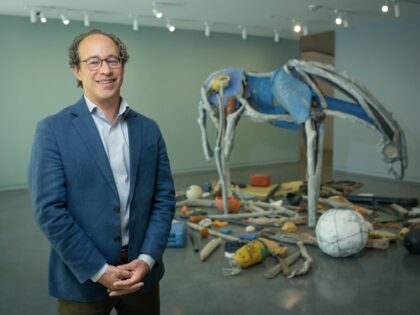By Anna Koster
For The Daily News
Pushing boundaries has been the life work of Robert Irwin. His six-decade exploration of perception as the fundamental issue of art has expanded ideas of what art can be and can do. Irwin will speak about his work on March 10 at Stanford’s Cemex Auditorium.
Irwin, born in 1928, in Long Beach, started as a painter in the 1950s with an abstract expressionist style, but quickly began removing all that was not essential. This resulted in his minimal “line paintings” and then canvases filled with fields of subtle gradations of color created by thousands of dots. He even tried convex canvases.
Dissatisfied with paintings trapped within a frame or contained by a canvas’ edge, Irwin devised his now-iconic works that merge with the light and air around them. His luminous disk paintings from the late 1960s made him a pioneer in the Los Angeles-based Light and Space Movement, along with such artists as Larry Bell and James Turrell.
I have admired Irwin’s disks in several museums across the country. The success of each one depends on impeccable installation: precise color of the gallery wall and exact placement of four spotlights. When properly displayed, the disk is otherworldly. It appears to be floating. The disk blends with its shadows, which in turn seem to take on substance and merge with the disk. Prolonged gazing can make a viewer feel that he or she is levitating along with the work.
Advertisement
One work in this series commands its own wall at the Anderson Collection at Stanford. A conveniently placed bench aids visitors’ contemplation of the piece. The acrylic disk, 53 inches across, sports one stripe that is translucent at either end and spray painted with a dark lacquer in the center. This creates a shimmering, then disappearing horizontal band. Seemingly supported by its shadows — the disk is held away from the wall by a hidden post — the work rewards viewers with a transcendent experience once they quiet their minds and sit for a while.
In 1970, Irwin took the next step in his artistic journey when he abandoned his studio to develop an unorthodox way of working, and began creating mostly site-specific, or what he calls “conditional,” pieces. His works in this category include the flowing, cascading, ever-changing Central Garden at the heart of the Getty Center in L.A. Aided by a team of engineers, soil scientists, plant experts and Getty staff, Irwin began work on the 134,000-square-foot garden in 1972. The garden opened to the public along with the Getty Center in 1997.
Irwin is gaining international attention for his massive, $5 million project on the grounds of the Chinati Foundation, the mecca of large-scale works in Marfa, Texas, founded by the sculptor Donald Judd. After more than a decade of planning, Irwin’s 10,000-square-foot structure, on the site of a derelict Army hospital, is slated for completion later this year. According to the Chinati Foundation website, the U-shaped construction responds to the ever-changing Texas sky and will be experienced in halves, with one side of the building dark and the other light.
He is expected to talk about this and other works when he talks at Stanford on March 10.
Email Anna Koster at annakosterart@gmail.com. Visit her website at annakoster.com.
Artist talk
Who: Robert Irwin
When: 6:30 p.m. , March 10; doors open at 6 p.m.
Where: Cemex Auditorium at Knight Management Center, 355 Knight Way, Stanford
Admission: Free. Registration requested but does not guarantee a seat
Registration and information: https://events.stanford.edu/events/577/57737/, 650-721-6053 or andersonevents@stanford.edu
Museum
What: Anderson Collection at Stanford University
When: 11 a.m. to 5 p.m. Wednesdays through Mondays; Thursdays until 8 p.m.
Where: 314 Lomita Drive, Stanford
Admission: Free
Information: https://live-anderson-collection.pantheonsite.io, 650-721-6055 or andersoncollection@stanford.edu





